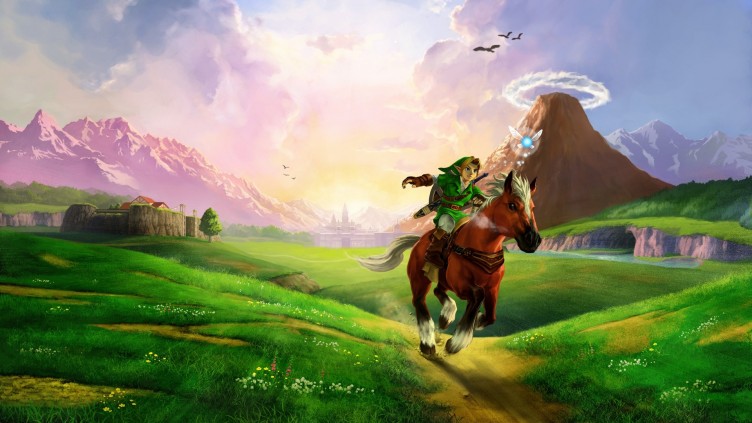
Over the past two or three years, I have almost unconsciously played a significant number of games in The Legend of Zelda series. In fact, I managed to play through all of the 3D games — aside from the bastardization that was The Legend of Zelda: Skyward Sword — and almost all of the main 2D games. While I had exposure and played many of these games before when I was younger, I hadn’t ever visited them in my adult phase of life where I can look at them with a more critical eye. I started to notice some of the ebbs and flows of the franchise and how it evolved into the state we see it today.
First, we must start with what defines a Zelda game. Many would describe these games as open-world adventures in which you delve into a series of dungeons, collecting unique items in order to trump evil. The world is at risk from some powerful evil entity, and most of the time, that evil is Ganon. What differentiates each game is some major twist on the formula. In The Legend of Zelda: Twilight Princess, you can turn into a wolf, and in The Legend of Zelda: Majora’s Mask, you have a ticking time clock. Very rarely does the series ever shake up this formula, but when it does, it usually results in success.
The Legend of Zelda started out as one of the pioneers of the open-world genre. You can truly go wherever you please and explore to your heart’s content. Over time, the series continued to adopt this open-world mentality, but it was the chunk of 3D games that warped what that open world looked like. There were large areas that you could explore that funneled into each other, but there wasn’t enough to do in them. Going back to The Legend of Zelda: Ocarina of Time for the first time in years, I was shocked at how boring Hyrule Field was. Even later in Twilight Princess, this bland open-world nature continued onward with far too many places locked off early and an opening that trudges far too long. Sure, it was fun to ride Epona through these landscapes when the games first came out, but going back now, these landscapes feel like time-wasting filler. On the other side, many of the 2D games kept offering an interconnected open world that’s ripe for exploration.
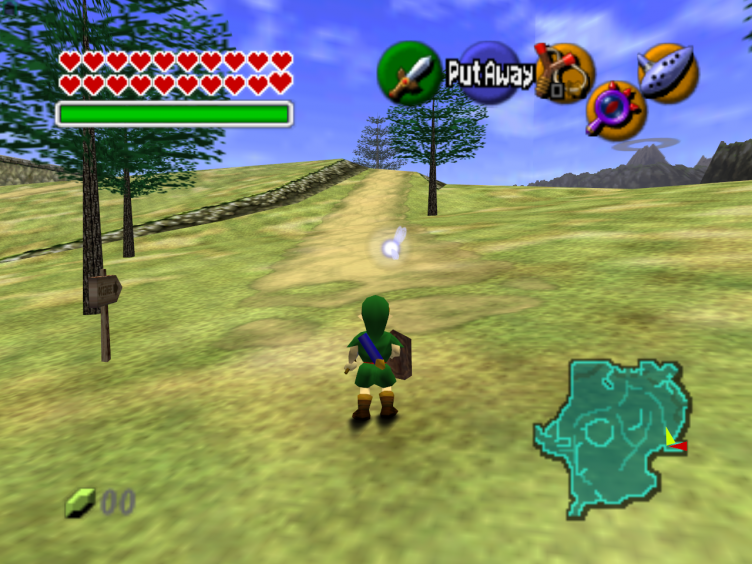
Hyrule Field was amazing for the time. Now? Not so much.
My personal favorite game in the series, The Legend of Zelda: The Wind Waker, brought Zelda’s open world back in the truest form since its early days. The ocean was a wonderful world to explore, chock full of interesting little islands and secrets. While some complained about the boredom of sailing, I always found it relaxing. More than anything, it felt like you were really on an adventure, sailing on the seas with something new to be discovered constantly in your view. It was also the first time in the series that Zelda had done something as radical as change the entire landscape from land to water. Skyward Sword tried to replicate that feeling, but its world felt far too barren and lifeless.
What’s an adventure without an interesting world and story to back it up? The Zelda series isn’t exactly known for its deep and thoughtful stories, with saving the world and Princess Zelda often being the main focus. How often it repeats this same story line is laughable, and it’s even more ridiculous that they managed to get away with it over and over. What makes this repetitiveness worse is that the pacing follows the exact same formula. You wake up, have some calling to save the world, have to collect three relics from dungeons, a major plot point happens, some more dungeons open up and then you have the final section and fight the big bad guy.
As I mentioned previously, when the stories and worlds get shaken up, a lot more interesting things happen. Majora’s Mask is the clear standout in how drastically changing the setup can lead to brilliance. The overall twisted tones of Majora’s Mask (mixed with the ever-impending doom of the Moon crashing into the world) really hammers in an incredible feeling of dread. It was also nice to have a sidekick in Tatl with some personality and an evil entity with some depth. To top it all off, Majora’s Mask had some of the best side quests that fleshed out the minor characters throughout Clock Town. It’s a shame that, to this day, no Zelda game has tried something as different as Majora’s Mask.
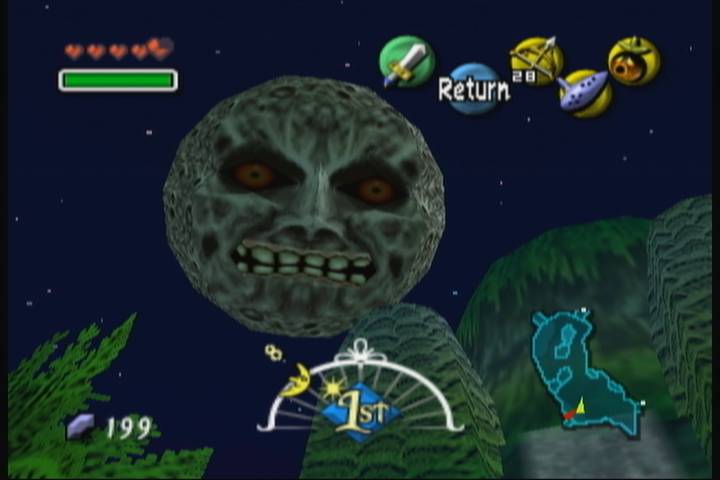
The constant threat of the Moon is always unsettling.
Before we hop into the dungeons, I want to briefly talk about the combat. The Zelda series has never been known for its swordplay, but there have been some flashes of greatness. Ocarina of Time had to deal with the awkward transition from 2D to 3D, and as a result, much of the swordplay revolves around waiting for the right time to attack an enemy. The Wind Waker took the series in the right direction, offering counters and interesting fights with enemies like the Darknut. Twilight Princess never really recaptured that same spirit because of the overall extremely low difficulty, and it also had the unfortunate awkwardness of combat as a wolf. Skyward Sword tried its own thing with motion controls that were a disaster and turned every fight into a chore. As for the 2D games, they’re more typically focused on puzzles because the hack-‘n’-slash nature does not allow combat depth.
Everyone loves the Zelda series for different reasons, but for me, it has to be the dungeons. The dungeons are quite simply brilliant game design, even if they sometimes don’t live up to expectations. I adored exploring these areas filled with interesting puzzles that require fun usage of new items. There’s a wonderful feeling of seeing all of these obstacles that you can’t overcome, finally getting that special item and going back to explore those previously locked areas. At the end of the dungeons, you have the crescendo in the form of an epic boss fight that tests your wits.
Upon revisiting games like Ocarina of Time and Twilight Princess, I was disappointed in how weakly the items were used in a good chunk of the dungeons. The Hammer, Hookshot and Spinner are just a few examples of items that are used about three times in their respective dungeons, aside from the boss battle. Compare this to something like the use of the Magnetic Glove in The Legend of Zelda: Oracle of Seasons where you constantly use it to push and pull objects around the dungeon to knock down the four pillars. Typically, the most satisfying and engaging dungeons are when multiple items collected throughout your journey are tested in conjunction. For example, a temple in The Wind Waker has you use the Iron Boots to launch off a spring, float using the Leaf and then land on the opposite side where you can then use your Wind Waker to take control of Makar to proceed onwards. In a similar vein, Majora’s Mask’s use of the different masks served as their own set of mechanics that allowed for depth in the dungeons.
Again, going back to these games that I had played in my youth, I was shocked at how trivial and boring about half of the boss fights were in the majority of the games in the series, at least from a game play standpoint. In my nostalgia-filled memories, the bosses were much more exciting than in reality. Where the bosses excel in visual and thematic designs, they often lack interesting mechanical prowess. Part of this is because the combat isn’t as refined as the puzzle elements. Despite this detriment, the boss fights tend to have this massive air of grandiose to them. With bosses 30 times bigger than Link himself, overcoming those odds using the item that you had just acquired and mastered felt incredibly rewarding, even if the fight itself wasn’t that complex.
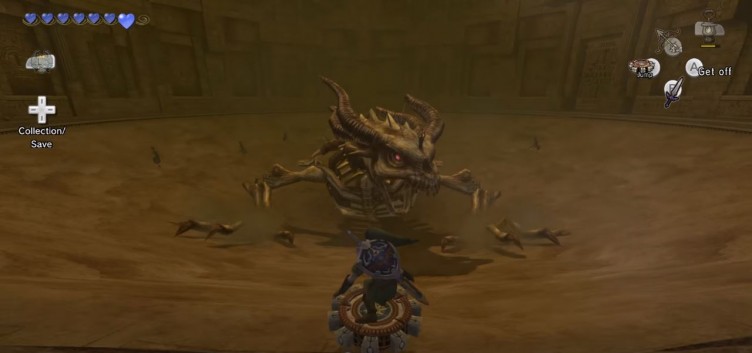
While the boss fights are easy, their design is fantastic.
Of course, a major component to the Zelda series has always been its iconic music. Over time, the franchise has continually gotten stronger and stronger with its musical offerings. Where it first stepped up its game was in Ocarina of Time. There was a shift that happened where more emphasis was placed on atmosphere rather than pure musical composition. The Forest Temple is a great example how a song can transform a simple forest area into an eerie and mysterious dungeon. The Ocarina itself served as a tool for creating simple yet memorable tracks and even kickstarted the trend for the rest of the games to have a musical element in the game itself.
Because it’s the most recent game that I’ve played in the series, I have to gush a bit about how outstanding the soundtrack is for Twilight Princess. There is an absurd number of brilliant tracks throughout the entirety of that game. The twisting, dark nature of the Twilight Realm, the bombastic horseback battles and the laid-back strings of Faron Woods are all expertly crafted to fit their respective atmospheres. My favorite musical touch happens in the boss battles. Upon opening up the weak point for attack, a musical flourish erupts, making you feel like even more of a badass as you mercilessly slash at the boss. I’m getting pumped just thinking about it.
You may have noticed a distinct lack of talk about the 2D games throughout this piece, but that’s not because of any hate. In fact, I think that, design-wise, the 2D games are some of the best. Puzzles are often smartly constructed throughout giant, nonlinear dungeons with ample item usage, the worlds are more fun to explore than their 3D counterparts and loads of interesting ideas are implemented because the 2D games are treated almost as spin-offs. The Legend of Zelda: A Link Between Worlds allowins you to choose the order of dungeons you visit, and this is the kind of great thinking that the franchise needs to continue and stay relevant.
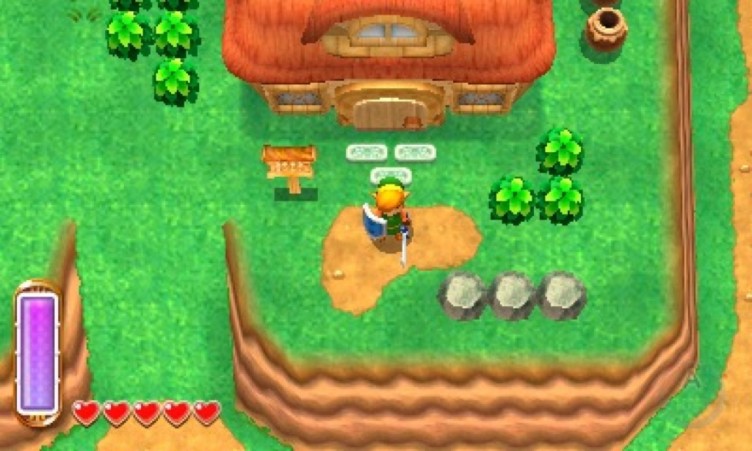
A Link Between Worlds was a fantastic return to 2D form.
As we near closer and closer to the next big Zelda game, a lot of speculation and discussion has been happening on what it needs to do to revamp the franchise. Namely, it should return to the roots of an open world that’s exciting to explore, possibly utilizing the aforementioned free dungeon order from A Link Between Worlds. It needs to start off quickly, not requiring you to go through hours of tutorials and story exposition like Twilight Princess or Skyward Sword. In a similar vein, this new Zelda shouldn’t treat you like an idiot where a companion repeats objectives to you or the camera pans to show you how to solve a particular puzzle. Bosses should be appropriately challenging and not pushovers where the strategy is apparent as soon as you walk through the door. Last, I would like a an actual remarkable story, one where Ganon isn’t the main enemy and one where I can emotionally care about the cast of characters. You know, Nintendo, just easily do all of that, and you’re good.
It has been really eye-opening over the past few years replaying all of these Zelda games that I had grown up with and adored. While I had a lot of disappointment in some things not matching up with my nostalgic memories, there was a lot more that pleasantly surprised me. Every time I fire one up and start to sink my teeth into it, I can’t help but get hooked. There’s just something about that sense of adventure that mixes puzzle solving, exploration and combat that’s so expertly crafted. From 2D to 3D, very few franchises have continually produced games as phenomenal as The Legend of Zelda. At the same time, the series has been stagnant in terms of fresh ideas while the same tropes and motifs are repeated constantly. Despite these games being well crafted, they’ve become predictable. Moving forward, I hope that Nintendo takes a good hard look at the series as I have done recently and really thinks about how they can bring The Legend of Zelda into the modern age of video games.
Just don’t pull that shit you did with Skyward Sword again, or we’re done.
